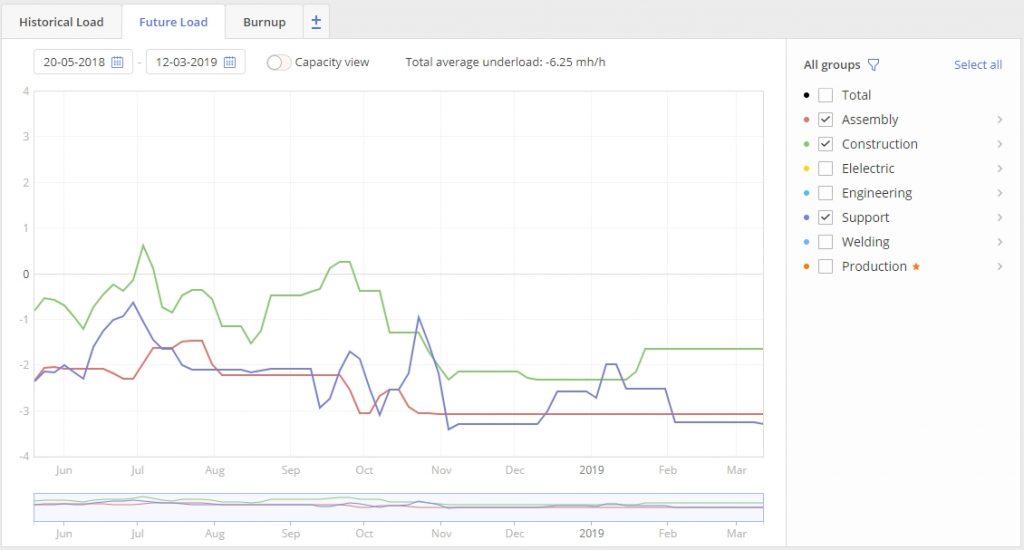It sometimes happens that an organization invests in implementing a resource management solution. But the results of this endeavor are far from satisfactory – the projects are still late and exceed the budget, team members are overwhelmed with the tasks, and the company’s business outcomes leave much to be desired. One of the reasons for that is making mistakes when working with this kind of tools.
What are these errors and how to get the most out of resource management software? Read further to find the answers.
The Most Common Errors Made by a Resource Management Solution’s Users
If you haven’t seen any positive changes upon the implementation of a resource management solution, you should check whether you haven’t made the mistakes listed below.
Incorrect data input
Let’s start from the “technical side”, namely the data input. Garbage in, garbage out – this proverb illustrates one of the sources of problems that prevent companies from achieving desired results. Correct data input is particularly important for AI-driven tools – it’s the basis for proper data processing and interpretation.
The most typical mistakes of the data input are as follows:
- Typos,
- Capitalized letters,
- Figures mixed with letters,
- Improper signs,
- Different data fields,
- Blank fields,
- Incorrect/inconsistent data format,
- Incorrect spelling.
They seem to be little things, but the tool can work improperly due to data inconsistencies, and the outcome won’t be as good as expected.
Considering work with the tool a formality
Despite the fact that a resource management solution can perform complex operations quickly and efficiently, it won’t work effectively enough if team members consider it just a formality. For example, if a user logs the hours spent for a certain task randomly instead of reflecting the actual progress, the data on teams’ progress won’t be completely accurate. Also, if employees aren’t aware of the importance of making timely updates to the system, they may simply forget about doing this or do it out of time. As a result, a project/resource manager won’t be able to draw relevant conclusions and improve project outcomes.
Ignoring the necessity of creating a project plan
The project management process involves creating a variety of plans (a resource management plan, a risk management plan, an implementation plan, etc.). Compiling all of them for each project in the environment may seem time- and labor-consuming and therefore sometimes neglected. Instead, some companies consider a cost management plan to be the most important. However, the correct and efficient work of resource management software is impossible without a project plan that will cover all necessary project-related information (the tasks to be completed, team members to assign to them, required material resources, etc.). Without a project plan, it will be very difficult to input the right data into the system, and it won’t be able to transform it into actionable insights.
Wrong task estimates and buffer management
Project team members may use an incorrect approach to task estimates, namely, adding a time buffer to each assignment and setting strict task deadlines. As a result, the employees will procrastinate and start work on a task as close to the deadline as possible. This phenomenon is called Student syndrome. In addition, task deadlines make the workflow subject to Parkinson’s law – it means that the amount of work expands so as to fill all the time allotted to complete it. So, if employees estimate task duration in such a way (with a time buffer added to task deadlines), the project work won’t be productive, and even the smartest resource management solution will hardly change the situation.
Making no conclusions out of the data provided by the system
To make the right decisions, you need to analyze the project-related information about the past (teams’ performance, project outcomes), the present (the actual state of a project environment), and the future (forecast phenomena that affect the final output). Implementing a resource management tool won’t change anything if the information it provides isn’t properly analyzed, or interpreted, and no conclusions are made. Let’s consider several examples of such mistakes.
Overlooking task priorities calculated by the system
When working in a complex multi-project environment, it’s extremely difficult to decide which of the tasks have the highest priority. Modern resource management solutions are capable of automatic prioritization of assignments across the whole project environment, which, of course, is a great help for a project and resource manager. If these priorities are neglected, and the order of completing tasks is based on a project manager’s or stakeholders’ assumptions, there’s a high risk of turning your project environment into chaos.
Ignoring the data on resources’ performance
Project managers who work in a multi-project environment often focus too much on projects’ progress, and pay insufficient attention to resources’ performance. However, when projects have shared resources, employees’ performance is not only the basis for productive project work but an important indicator of the whole project environment’s “health”. Due to dependencies between projects, one single employee who doesn’t cope with their workload can become a source of problems for the whole project environment. What is more, the consequences of problems on the resource level will be reflected on the project level over time, and it can take a lot of effort to change the situation.
Read more: Tracking Performance: Switching from Project to Resource Level
Misinterpreting the information provided by the system
To make the right decisions that can transform the project and resource management process for the better, information provided by the tool (e.g., graphs showing resource utilization or workload, etc.) should be correctly interpreted. The system transforms the raw data into information and presents it in a certain way, but it’s up to a project/resource manager to make sense of it and draw the right conclusions.
Now, let’s consider how project and resource managers can avoid these mistakes and get the maximum out of a resource management solution’s functionality.
How to Make a Resource Management Solution Work to Your Advantage?
 In this section, we’ll provide general recommendations and illustrate them with examples of Epicflow, an AI-driven resource management solution designed for work in a multi-project environment.
In this section, we’ll provide general recommendations and illustrate them with examples of Epicflow, an AI-driven resource management solution designed for work in a multi-project environment.
Prepare your data thoroughly
For the solution to be able to transform your workflow for the better, you have to input all the necessary data. But first of all, you should take the following steps to prepare this data:
- make sure that the data in documents is structured – it will make it easier for a tool to process it;
- ensure data integrity: use templates or standards to make the data coherent across all projects;
- create project history: upon project completion, register all related information in a single repository.
Read more: Garbage In, Garbage Out: How to Prepare Your Data for AI-Driven Project Management Tools
Provide every project team member with enough instructions and support
Firstly, it’s very important for every single user to be aware of the purpose of implementing the resource management solution – what company’s pain points are going to be addressed, what processes are expected to be improved, and how the solution will transform the team members’ everyday work.
Secondly, they should be informed of their part of responsibility for a solution’s correct functioning (e.g., making the right task estimates, updating remaining and spent hours regularly so that they reflect the actual progress). For example, Epicflow users should be aware that its approach implies no strict task deadlines, and the team members are expected to complete their tasks as soon as possible to eliminate the negative consequences of Student syndrome and Parkinson’s law.
And finally, the users should be provided with overall support – onboarding, workshops, technical support, etc.
Follow the system’s suggestions
Working in a multi-project environment, a project/resource manager has to analyze myriads of data. First of all, this refers to deciding on task priorities and assigning resources to these tasks. When it comes to processing large amounts of information, it’s better not to ignore the options suggested by the system. It will save a project/resource manager’s time and effort and contribute to much better outcomes.
Speaking about Epicflow, its suggestions can optimize the resource allocation process. The system analyzes each employee’s availability, capacity, and competence level to suggest a perfectly matching employee for completing a task. It’s extremely difficult to analyze all this data and come up with the right decisions when there are thousands of employees working on hundreds of projects. So, such assistance from resource management software shouldn’t be neglected. The same can be said about task prioritization in Epicflow. It automatically calculates task priorities across the whole project environment so that each team member works on an assignment that is most critical for timely and successful project delivery for the moment.
Get maximum insights for informed decision-making
Try out scenarios before implementing any changes to your project environment
Making ad-hoc decisions and changes to the project environment is the direct road to failure, especially in the environment where projects are dependent on each other. Fortunately, modern resource management tools are capable of scenario analysis, i.e., predicting outcomes of these changes and decisions (e.g., how will the project setting change if you reallocate resources, move milestones, or add one more project?). So, before implementing any changes or making a decision under conditions of uncertainty, a project/resource manager can analyze these scenarios in real time and base their resolution on them.
Draw the right conclusions from the resource performance analysis
The analysis of resource performance will provide you with the following insights:
- you will find out whether your team members are productive and cope with their workload or it’s unbalanced (some of them are overwhelmed while others are idle);
- you will get an idea of your project environment health based on employees’ performance;
- you will be able to use this information for future estimates to know what output to expect of your team members.
Let’s look at the example of Epicflow. Its Future Load Graph analyzes the data on employees’ involvement in active projects and builds a corresponding graph showing team members’ expected workload and output in the future. This information must be properly interpreted: the graph has a zero line, and if a resource (resource group) is expected to be overworked, the line indicating this resource/group will be placed above this line. It signalizes that there’s going to be a bottleneck, and a project/resource manager has to take corrective measures. If not, an overloaded employee or a resource group will become a bottleneck for the workflow. If it’s under the line, an employee doesn’t work according to their capacity.

Epicflow’s Historical Load Graph shows how employees’ workload changed over time in relation to their capacity. Upon correct interpretation, it can provide a project/resource manager with valuable insights, e.g., detect idleness (not working at one’s full capacity), which can significantly hamper the flow but is almost impossible to spot with the naked eye.
Let the resource management tool automate processes
In addition to automatic prioritization and resource allocation mentioned above, a resource management solution can assist in reporting. Creating reports is an integral part of a project/resource manager’s work. When resource management software works properly (the data in the system is correct and timely updated), project and resource managers can generate reports in the system instead of being busy gathering all the necessary information and compiling them manually. As a result, they will have much more time for important and creative tasks, while the tool will automate a significant part of their work.
Also, resource management tools can integrate with other solutions. For example, the integration with a human resource management system will provide real-time updates about resource availability, which is critically important for effective resource allocation.
Therefore, a resource management tool being combined with a project/resource manager’s expertise can really transform the project and resource management processes for the better, and let an organization reach new heights.
If you want to learn more about Epicflow and how it contributes to positive transformations in your company, don’t hesitate to contact our experts.

